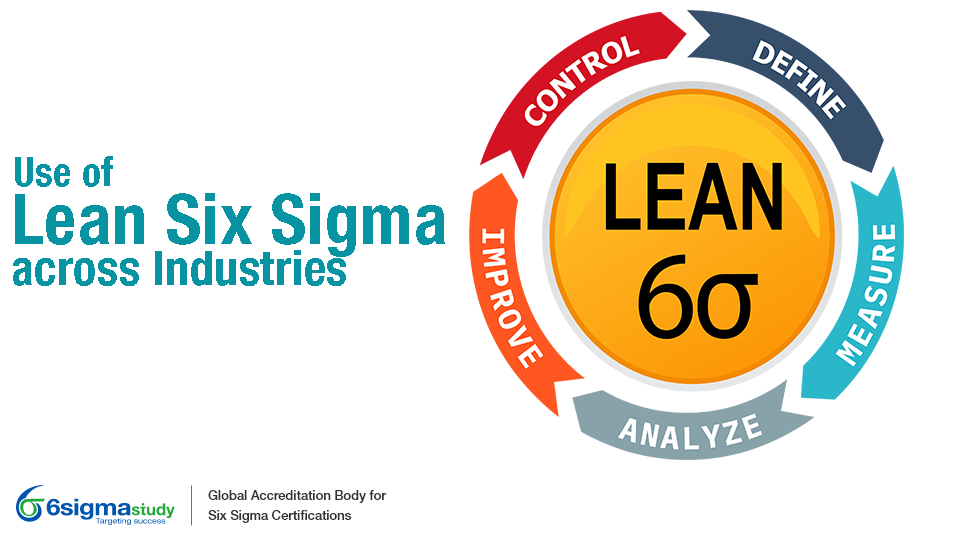Use of Lean Six Sigma across Industries
Posted by 6sigmastudy® on December 08, 2023 | Six Sigma Methodology
Keywords: Six Sigma 6sigmastudy Six Sigma across Industries Six Sigma Yellow Belt (SSYB™) Six Sigma Green Belt (SSGB™) Six Sigma Black Belt (SSBB™) Lean Six Sigma Green Belt (LSSGB™) Lean Six Sigma Black Belt (LSSBB™) Free Articles Free Six Sigma Articles TQM Six sigma define dmaic dmadv
Lean Six Sigma stands out as a powerful tool. It combines Lean and Six Sigma methods to cut waste, fix flaws, and improve productivity seamlessly. Contrary to a common misconception, Lean Six Sigma isn't limited to manufacturing or supply chain operations. Instead, it's a flexible method that can be used in various industries. This article delves into how Lean Six Sigma is bringing notable improvements in various industries such as healthcare, finance, information technology, the textile industry, education, and the government sector.
-
Lean Six Sigma in Healthcare
In healthcare, errors can have serious consequences for both finances and lives. Lean Six Sigma methods are essential in lowering the chances of making mistakes, reducing wait times, lowering mortality rates, and enhancing patient care. When used in labs, Lean Six Sigma helps speed up testing processes, cutting delays and boosting overall efficiency. The approach also focuses on preventing mistakes in pharmaceuticals, making sure prescriptions are filled accurately, and medications are administered correctly. In the end, Lean Six Sigma in healthcare is a remedy for improving the quality of care and satisfaction of patients.
-
Lean Six Sigma in Finance
In the quick-paced realm of finance and accounting, operational inefficiencies can create notable risks. Lean Six Sigma is used to simplify processes, remove tasks that don't add value, and get rid of errors. Whether dealing with a bank loan application or managing insurance quotes, applying Lean Six Sigma guarantees faster and more precise responses to customer needs. Finance companies also use Lean Six Sigma to build data warehouses, saving time and effort in handling financial data, client reports, and contact information.
-
Lean Six Sigma in Information Technology
In the ever-changing field of information technology, being quick to launch and efficient in operations are crucial for staying competitive. Software companies use Lean Six Sigma to assess and improve both business operations and internal processes such as network performance and reliability. This approach improves the overall effectiveness, productivity of the workforce, and how resources are used in the IT sector. It not only adds to the quality of services and products but also boosts how well operations are carried out and managed, making sure services remain stable.
-
Lean Six Sigma in the Textile Industry
The textile industry encounters various challenges in making garments, resulting in quality issues, alterations, and rejected products. Lean Six Sigma plays a crucial role in pinpointing and addressing these issues, ultimately enhancing production efficiency and elevating the quality of clothing. Lean Six Sigma improves processes at every step, starting from obtaining and checking fabrics to sewing, embroidery, packaging, and shipping. This reduces the number of rejections and boosts the market appeal of the industry.
-
Lean Six Sigma in Education
Efficiency and effective use of resources are crucial in education. Lean Six Sigma helps schools simplify administrative tasks and enrolment processes, enhance student satisfaction, and optimize the performance of both teachers and students. By using Lean Six Sigma principles, schools can find areas to improve, making sure resources go to the classroom and the academic system runs at its best.
-
Lean Six Sigma in the Government Sector
Government organizations also feel the need for efficient resource use and better service delivery. Lean Six Sigma provides tools for the public sector to pinpoint where costs can be cut, remove unnecessary positions, and raise the quality of services. Using Lean Six Sigma methods, government bodies can outline specific, valuable roles and duties, ultimately enhancing process efficiency and meeting public expectations.
Lean Six Sigma stands out as a versatile and transformative methodology applicable across a spectrum of industries. It emphasises on data-driven and analytical approaches equip organizations with effective tools to pinpoint inefficiencies, reduce errors, and enhance overall processes. It also ensures that processes not only operate efficiently but also align with the diverse needs of customers and the overarching goals of the organization. Embracing Lean Six Sigma is not merely a strategic decision; it signifies a commitment to continual improvement, providing a clear pathway to sustainable success in today's highly competitive business environment. By adopting Lean Six Sigma principles, businesses position themselves to adapt, thrive, and deliver value in the face of dynamic challenges.
For more such interesting articles on Six Sigma and its concepts, please click here

